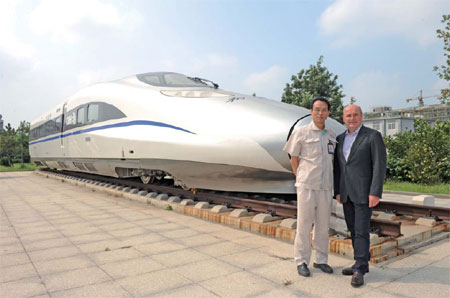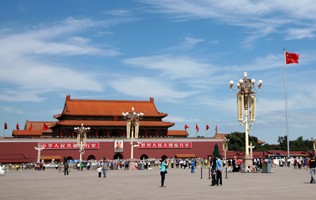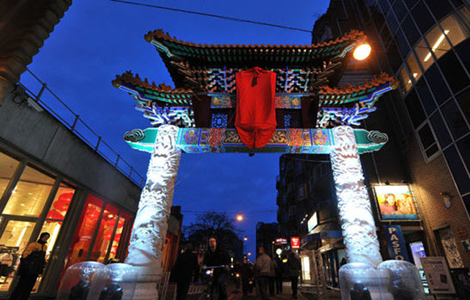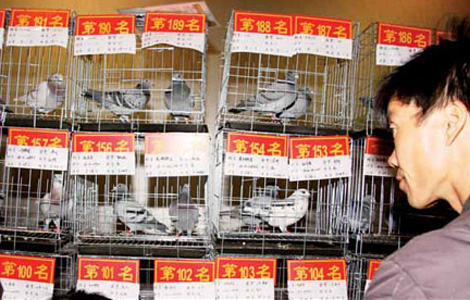Designs that become high fliers
By Cecily Liu ( China Daily Europe ) Updated: 2014-03-07 10:01:42|
Paul Priestman, director of Priestmangoode, and Gong Ming, chief engineer of CSR Qingdao Sifang Locomotive and Rolling Stock Co, with one of the high-speed trains that has been developed during the companies' partnership. Provided to China Daily |
A small British company has been the driving force behind some of the impressive and best-known designs for China's high-speed trains, electronics products and major white goods brands.
Priestmangoode of London, which had annual turnover of 6 million pounds ($10 million, 7.3 million euros) in the latest financial year and employs about 50 people, also has a diverse customer base that is a virtual roll-call of global marquee brands ranging from Airbus, Thai Airways, Heathrow Airport, Virgin trains and Marriott Hotels.
Paul Priestman, director of Priestmangoode, says that unlike other industries, design is not an industry where big deals are clinched on the basis of headcount. Rather, what tilts the scales is international perspective, creativity and flexibility, key attributes that have helped the company succeed in China.
"If an (overseas) client wants me to be there tomorrow because they think it is important, then I'll just rearrange my schedule and go, because that's how we work," says Priestman, who runs the company with his partners Nigel Goode and Luke Hawes.
Priestman says he has always been fascinated with China and visited the country as a student about 20 years ago. However, his business association with China began only in 2006, when he went to Wuxi to deliver a lecture on design innovation.
That visit was propitious as Priestmangoode, which had just finished working with Airbus on an aircraft, established contact with CSR Qingdao Sifang Locomotive and Rolling Stock Co, the Chinese high-speed train maker, which was looking to expand its design team.
In 2008, the two companies formally signed a contract to undertake joint design of high-speed trains, including the train exteriors and interiors. "Everything the customer sees and touches has been designed by us," Priestman says.
Expanding on the alliance, Priestman says the CSR Sifang trains are ultra modern in design, and a good representation of China's growing economic prowess and culture.
The good use of bright colors like blue and red in the trains' exteriors and the comfortable and luxurious interiors are a revelation in terms of design aesthetics. The hot-water dispensers installed on the trains are synonymous with Chinese tea, and the swivel function of the seats ensures that travelers never face backwards.
In 2011 Priestmangoode established an office in Qingdao to further support its partnership with CSR Sifang, and last year Priestman was made the global creative director of CSR Sifang, allowing him to further lead the team of about two dozen designers.
As part of the partnership, Priestmangoode hosts designers from CSR Sifang in its London office on short placements, and works with them on design and in using advanced design software.
But only designing the individual elements that make up the high-speed trains is not good enough, Priestman says. Rather, he believes the team's biggest asset is the innovative approach it brings to the design process.
Unlike cars, which may last for just three years before a new model is launched, trains normally last for more than 20 years before being replaced.
Priestman says his team needs to think about developing technologies and customers' needs in more than a decade's time and make allowances for them in its design work.
"We are constantly looking at things around us. We always have to think ahead. Obviously, you can't research the future, but we always have to think, 'What is this place going to look like in 10 years time?'."
One example is the gradual disappearance of screen advertisements on public transport, he says.
Trains now have many more advertisements on screens than do aircraft, where more and more passengers are using tablets and phones. So in the future advertising may shift to advertising on windows when the technology makes that possible.
"We are aware of (such potential technology), we research it, and we understand what possible requirements would be. For window displays, we would need to get power to the glass, so we allow space for electric cables in the design today. It's future proofing."
Priestman also talks of the possibility of embedding solar panels into glass to help trains generate power to run.
As global creative director, Priestman's job goes beyond the design process. He works with engineers to ensure designs can be implemented properly.
He feels large engineering companies traditionally may not have realized how important design is, so may have engineers greatly outnumbering designers, something that happens everywhere.
CSR Sifang initially had a limited understanding of design and its value to business, he says, which added to the challenge, and that is why it took more than a year from discussions in 2007 to the signing of the first contract with Priestmangoode in 2008.
"However, the partnership has blossomed, and now, when they say 'Can you do it next week?" and we say, 'It really takes four months', they understand the complexities of the design process, the software we use."
Priestman is optimistic about China's design market, believing it has vast opportunities to grow because creativity will give China a new competitive edge when the country's manufacturing advantage disappears.
"Only one company can be the cheapest, and the rest is design. Why are people willing to spend more than others? That's all to do with what we can bring to a market."
Priestmangoode has also started to design electronics products for Chinese telecommunications giant Huawei and white goods maker Haier.
Its designs for Haier are mainly for the company's export range, and involve extensive use of its customer knowledge in various places.
For example, Western consumers may wish to buy a week's supply of groceries, whereas in China consumers may buy in a traditional market every day, so the design of the fridges will be different.
Western fridges need to take into consideration the standard size for milk cartons, whereas in China dairy products are not that extensively used. French fridges almost always have a section for cheese, whereas Chinese fridges will have holders for eggs because eggs are typically not sold in boxes in China.
Understanding the correct needs of each market is important, because the tiny details that make up the fridges' design may determine a consumer's decision, Priestman says.
Despite having customers globally, Priestmangoode's Qingdao office is the firm's only international office, the Chinese market being seen as particularly important. At the same time, the necessity of a physical office may also point to the toughness of the Chinese market.
"We are aware that communication is important in China. The language issue means having an office which can translate and communicate is important," Priestman says.
Many Western businesses fail in China because they do not understand the Chinese way of relationship building, he says, and years of work in China has taught him that one should only expect to meet someone in charge on the third visit.
With a global growth of over 20 percent a year over the last three years, Priestmangoode is looking for even stronger growth in China.
Priestman is particularly excited about the opportunities in the cruise ship and aviation industries, and believes China's relaxation of private ownership of aircraft will create new opportunities for Priestmangoode.
Other opportunities include city transport and public infrastructure, he says. "China's ambition and investment in the aviation and transport industries and Priestmangoode's expertise as leaders in global travel and transport design means we are likely to see much more from this British design studio over the next few years."
cecily.liu@chinadaily.com.cn
|
|
|
|
|
|
|
|
European Weekly
 We will not give up search, Li vows
We will not give up search, Li vows
International hunt for missing airliner continues after fruitless six-day search























